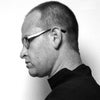DANIEL MAIDMAN: I've had a chance to spend some time with Temple Tomb Fortress Ruin, John Wellington's solo show, curated by gallery director Jason Patrick Voegele, at The Lodge Gallery. John, I've been familiar with your work for a long time, but I've never sat down in person with a large number of your pieces. I came away from it feeling like I had a better grasp of the breadth and complexity of your vision as an artist. I'll go ahead and confess that I've spent a long time focused, when considering your work, on your cheesecake motifs, and wishing you would more directly address your personal connection with this set of images. Looking at a lot of the work together, though, persuaded me that perhaps you are admitting as much as the work requires, and that this thread is in fact one of many to which you have shown yourself equally committed over time. Anyway, I was really captivated by your invocation of a quirky, intensely colored universe in which any number of themes could be explored: Japanese pop culture, the implosion of Western civilization, the apocalypse, sexual menace... There's a lot of territory, but if you're interested, I'd love your thoughts on two startling myths which recur throughout the show: a modern, militarized Chinese Artemis, and the beheading of John the Baptist as played by Michelangelo's David.
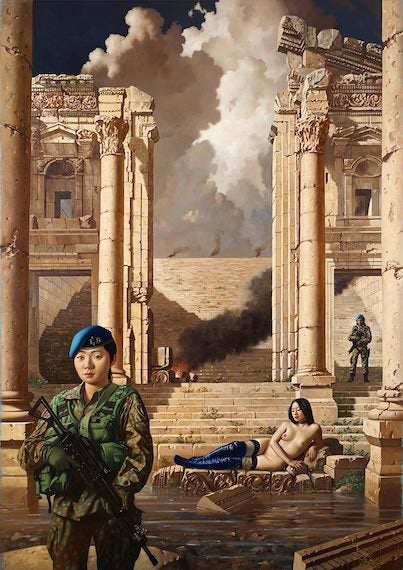
JOHN WELLINGTON: First, thank you for taking the time to really look at the art - and that of course means, seeing not only the surface motifs, but going to deeper layers to understand why those surface motifs are important to the work as a whole.
The use of Diana/Artemis, and references to Salome and the head of John the Baptist are not literal interpretations of their stories but more to do with my attraction to powerful women, even when that attraction might be to the detriment of men. Diana in the two paintings shown in Temple Tomb Fortress Ruin, is guarded by women, although in both paintings the ruin-scapes reference an Empire fallen. Even with the soldier’s protection, the world Diana inhabits seems fragile, if not for her, then for us. The “David” head, a cast for academic study, has been a recurring theme in my art for almost two decades. Sometimes it has represented me as a decapitated but observant onlooker, other times, it has represented the fall of men. If there is an ambiguity or contradiction to the interpretation of the visual stories that the use of these and other images invoke in my art, that is by design. I am the opposite of a conceptual artist in this way; having a specific point of view or agenda, and fabricating a work to support that view. Often my interpretations shift or change, not only when in the act of creating, but years later, looking at my work as a viewer. I enjoy the mystery and multiple interpretations that can come out of my art when at its best.
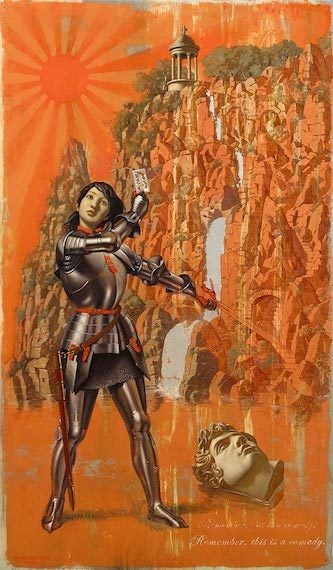
John Wellington, THIS IS A COMEDY, 2010, 48 x 28.25 inches, oil and aluminum leaf on aluminum
DANIEL MAIDMAN: This touches on something I came to appreciate in your work while I was studying it, a quality is shares with the Jan Fabre sculptures I was studying recently: that instead of providing a schematic for the viewer which leads to a predetermined conclusion, I see the work as focusing on creating an image which resonates in a number of dimensions, generating a cloud of possible meanings and interpretations. The identification of the head of the David with the head of John the Baptist not only provides a rich font of images for you as an artist, but allows the viewer to bring a lot of different things to the viewing, and to have those things rewarded by bouncing them off the work. To the extent that you guide the viewer, my sense is that your guidance involves setting a mood - the drama, the sexual aggression, the dreamily detached sense of disaster and doom... Jason, does my take on this match your experience with John's work? I feel like your selection and arrangement of pieces maintains John's forbearance, that they don't force a perspective on the viewer. How does your take on these qualities of the work affect your curation of a show of it?

John Wellington, COME NEARER THE FIRE, 2008, 75 x 48 inches, oil and copper leaf on aluminum
JASON PATRICK VOEGELE: It does in a number of ways. I think, for example, that when we consider the tension in what appear to be post apocalyptic worlds populated by representations of dominant female archetypes, or goddesses and women warriors juxtaposed against the backdrops of traditionally male dominated historical landscapes, there is an impulse for the viewer to want to make connections between the disparate symbols and incongruity. In doing so each viewer creates their own guided narrative based on their own cultural perspective and concept of self. Each piece is then a mystery and depending on how engaged you are in the mystery there is an endless visual meditation to be explored in layers of surface and depth. This idea was a heavy consideration in regards to the work that was selected for the exhibition. John has incredible range as a master of his craft so as the pieces that were culled from approximately the last ten years try to reflect that level of skill, the real challenge was to pull together a body that most reflected John's recurring standards of beauty, mythological themes and the provocative symbology that has transversed his career. In that manner the arrangement of the work in the gallery was coordinated to reflect and highlight these concepts.
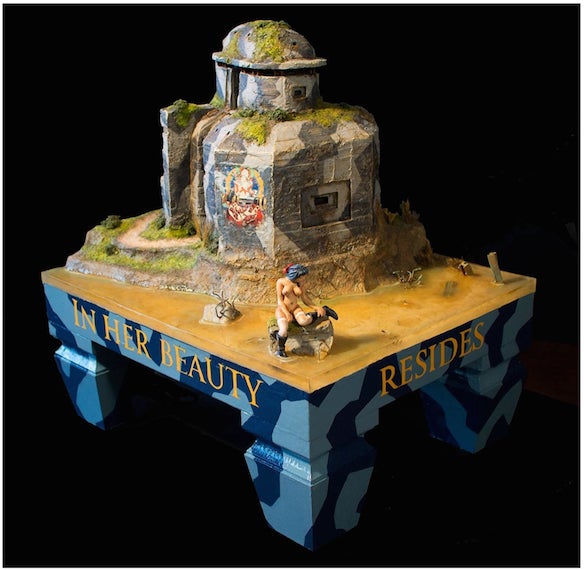
John Wellington, IN HER BEAUTY RESIDES MY LIFE AND DEATH, 2016, 16 x 13 x 15.5 inches, resin/oil/wood
DANIEL MAIDMAN: Included in the show are a number of sculptures of, as I understand it, temple-bunkers. These have been described to me as "prototypes" - technically, they are much more primitive than the paintings, but they are clearly part of the same universe, as if a different viewer were making images of the same underlying reality. A bunker of the same type appears in one of the most recent paintings, Hero. To me it has the blank menace of the ghost town at the beginning of Miyazaki's Spirited Away, and like that town, may hold worlds in it, many of them full of companionship and union. Tell me more about the role of the temple-bunker, and about where you are and where you're going with the sculptures.
JOHN WELLINGTON: The Temple Bunkers had their genesis two years ago when composing and ready to begin a painting where I knew “the answer.” Understanding what the painting would look like when finished made the process dead to me and so it was never painted. Instead, inspiration was found in my childhood, as an obsessive eleven year old, painting lead and plastic soldiers and building dioramas, where they would sometimes be displayed at Polk’s Hobby Shop on Fifth Avenue.

John Wellington painting toy soldiers, Greenwich Village, 1973
JOHN WELLINGTON (cont’d.): I have drawn and painted bunkers all my conscious life, and they have reappeared throughout my adult work. With painting at that moment lacking a mystery for me I began sculpting architecture, based partly on real bunkers that I had painted en plein air in Normandy, and also from imagination. The sculptures are more than just bunkers for me. They are a place of worship, a place of spiritual sanctuary, but also as importantly, a ruin and maybe my tomb. Figures at approximately 1/32 scale, a “toy” size, began to populate this world, bringing my childhood hobby into the same realm as my adult paintings. These sculptures are not prototypes or maquettes for me. There are many directions to evolve with the sculptures which will keep working in three dimensional space exciting for me, and future works might incorporate video, a larger scale, and more figures.
My art is forever changing, responding to my ideals/ideas of beauty, my fears, my visions, my past lives, and my current world. The art is made to channel and control all those swirling energies around me; war, death, sex, desire, politics, religion, and history. When I am challenged, confronted and surprised by my art, that’s when it succeeds for me.
As a side note, I have watched Spirited Away multiple times and love it on so many levels. I would say that the Temple Bunkers may at times be a ghost town or haunting for me - especially as a ruin and tomb. Unfortunately, these Temple Bunkers lack that delectable food that turned Chihiro's parents into pigs. I always felt that was a fair trade off.
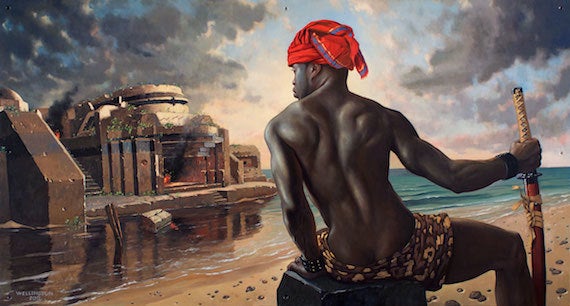
John Wellington, HERO, 2016, 26 x 48 inches, oil on dibond panel
DANIEL MAIDMAN: You remind me of a comment my wife made about a painting I really liked. She said, "Yes, but it's not great." I said, "I can see what you mean, but why not?" And she said, "Because the painter knows how it's going to turn out." This quality of being surprised by one's own work, of becoming subordinate to a direction you yourself cannot anticipate and perhaps can never even understand - is very important to me, and it sounds like you are radically adjusting your art-making process right now to accommodate that kind of openness. In my life, I find that these accommodations take the form of periodic revolutions, after which there is much work to be done, until the work becomes too practiced, and then no matter how much I have enjoyed making the work, it is time to move on. Can you tell me a bit about your own creative life, when viewed in this sense? And then, Jason, does this idea come into active play for you as a curator, in terms of your own growth or the types of work you're attracted to?
JOHN WELLINGTON: Even when studying printmaking in college, I enjoyed the mono-type more than re-printing the same image – and the monotype basically negates the reason for the printing press. If I find myself going through the motions of creating then I stop, contemplate what is missing, and alter the process until I am fully reengaged and devotional in the moment.
There are paintings in the show where x-rays would reveal both pictorial and conceptual shifts in the process to create something unexpected for me. “For Your Dreams” began as a still-life of three skulls with the Louis Vuitton monogram in the background. Finding it conceptually trite, I almost discarded the work. Instead, I painted leaves around the skulls. Still dissatisfied, I painted a landscape with dark clouds and a factory covering up the skull on the right. An island, river, and boat appeared, maybe referencing Böcklin’s "Isle of the Dead” and the River Styx. The sky was repainted until it became a suggested sunset. The words “one life for yourself and one for your dreams” - a lyric from a James Bond theme song - were written on the bottom right. And then two paths appeared on the island. That is often the process of my art, one of mystery and active inspiration.
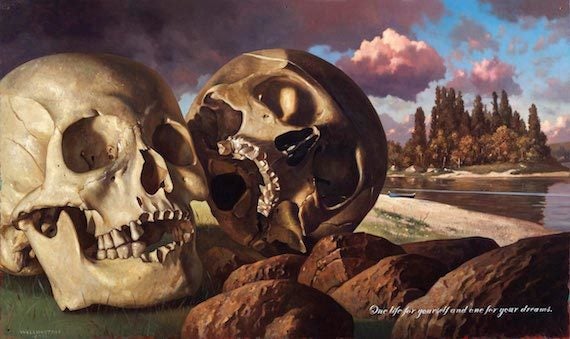
John Wellington, FOR YOUR DREAMS, 2013, 28.25 X 48 inches, oil on aluminum panel
JASON PATRICK VOEGELE: I can only speak for myself but I’ve always felt that if things don’t evolve they die. I’ve had a variety of aesthetic and conceptual interests in the projects I’ve produced and the artists that I’ve been fortunate enough to work with over the years. For example, in grad school I was enamored with site specific installations, my first serious gallery job was working for an outsider art gallery, following that I worked for almost six years absorbed in photography and video, my first independent gallery venture in Brooklyn focused mostly on emerging sculptors, video and performance art and now at the Lodge Gallery we primarily exhibit mid-career representational artists. Lately I’ve been really interested in immersive AI as well. So yes all of the various avenues and niches of contemporary art have fascinated me at different times and the more experience I have working with artists of all kinds the more it helps to inform curatorial decisions or what projects to take on in the future. I think projects seem the most fresh when there is a balanced element of familiarity and experimentation. One of my favorite aspects of the unique nature of The Lodge Gallery is that although we do have a somewhat defined vision for our programming, we are able to routinely take risks and experiment with new ideas. So we are still growing.
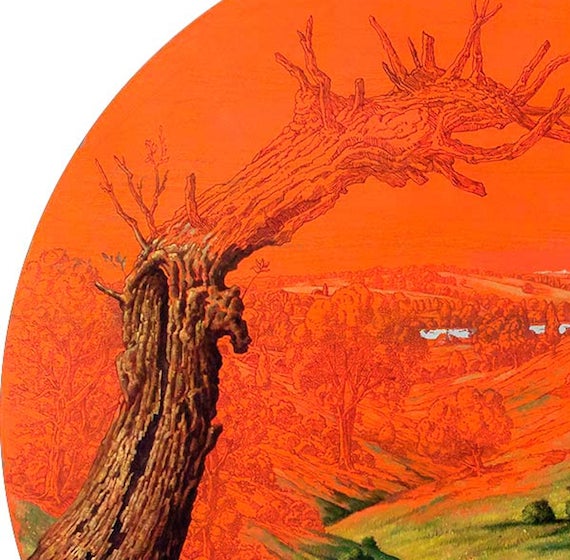
John Wellington, PROPHETE (detail), 2011, 48 inches in diameter, oil on wood panel
---
John Wellington TEMPLE TOMB FORTRESS RUIN
January 25 - March 5, 2017
The Lodge Gallery, 131 Chrystie St., New York, New York, 10002
